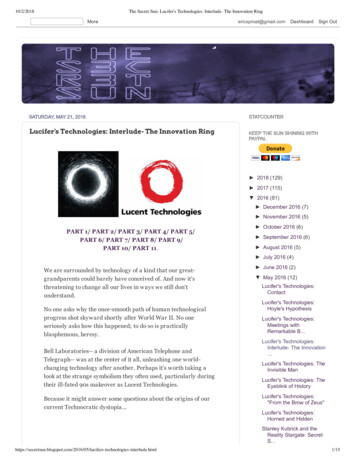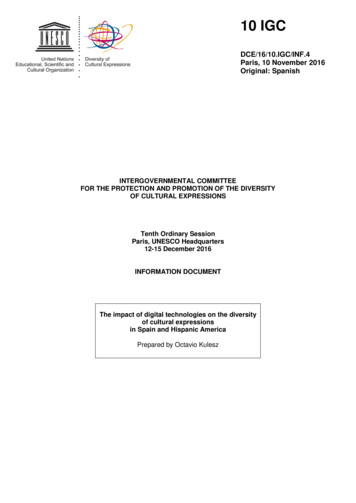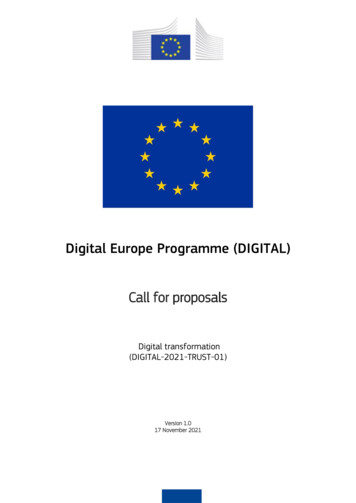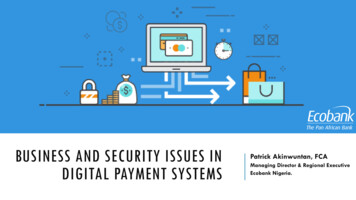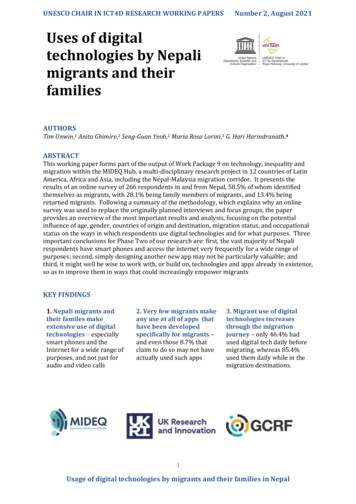
Transcription
UNESCO CHAIR IN ICT4D RESEARCH WORKING PAPERSNumber 2, August 2021Uses of digitaltechnologies by Nepalimigrants and theirfamiliesAUTHORSTim Unwin,1 Anita Ghimire,2 Seng-Guan Yeoh,2 Maria Rosa Lorini,3 G. Hari Harindranath.4ABSTRACTThis working paper forms part of the output of Work Package 9 on technology, inequality andmigration within the MIDEQ Hub, a multi-disciplinary research project in 12 countries of LatinAmerica, Africa and Asia, including the Nepal-Malaysia migration corridor. It presents theresults of an online survey of 266 respondents in and from Nepal, 58.5% of whom identifiedthemselves as migrants, with 28.1% being family members of migrants, and 13.4% beingreturned migrants. Following a summary of the methodology, which explains why an onlinesurvey was used to replace the originally planned interviews and focus groups, the paperprovides an overview of the most important results and analysis, focusing on the potentialinfluence of age, gender, countries of origin and destination, migration status, and occupationalstatus on the ways in which respondents use digital technologies and for what purposes. Threeimportant conclusions for Phase Two of our research are: first, the vast majority of Nepalirespondents have smart phones and access the internet very frequently for a wide range ofpurposes; second, simply designing another new app may not be particularly valuable; andthird, it might well be wise to work with, or build on, technologies and apps already in existence,so as to improve them in ways that could increasingly empower migrantsKEY FINDINGS1. Nepali migrants andtheir familes makeextensive use of digitaltechnologies – especiallysmart phones and theInternet for a wide range ofpurposes, and not just foraudio and video calls2. Very few migrants makeany use at all of apps thathave been developedspecifically for migrants –and even those 8.7% thatclaim to do so may not haveactually used such apps3. Migrant use of digitaltechnologies increasesthrough the migrationjourney – only 46.4% hadused digital tech daily beforemigrating, whereas 85.4%used them daily while in themigration destinations.1Usage of digital technologies by migrants and their families in Nepal
UNESCO CHAIR IN ICT4D RESEARCH WORKING PAPERSNumber 2, August 2021IntroductionThis is the second in a series of working papers presenting the initial findings from researchconducted by Work Package 9 of the UKRI GCRF funded MIDEQ Hub 1 into how migrants usedigital technologies. This work package is one of three “intervention” packages within MIDEQ,2and has the overarching objective of facilitating the crafting of a digital intervention (orinterventions) that will contribute to reducing inequalities associated with migration betweenand among a selection of the 12 countries chosen for study by the MIDEQ leadership in Africa,Asia and Latin America. This second working paper summarises the results from collaborativeresearch with migrants from Nepal.A three-phase approachOur work package has adopted a very specific three-phase approach to deliver its overallobjective. It is designed explicitly to learn from and work with migrants and local techdevelopers to craft an intervention of their choosing. The first phase of the research (2019-20)aims to understand better how migrants currently use digital technologies. Originally, this wasintended primarily to be undertaken through interviews, focus groups and other qualitativemethods in four of the MIDEQ migration corridors (China-Ghana, Ethiopia-South Africa, HaitiBrazil, and Nepal-Malaysia). Building on this, the second phase (2021-22) aims to explorefurther how migrants understand the notion of inequalities associated with migration, whatthey might like to change, and how digital technologies might be able to effect such change. Thisphase seeks to combine migrants’ understandings of migration inequalities with the digitalexperiences of colleagues within the work package. The third phase is to facilitate interactionsbetween local tech developers and migrants, with the intention of crafting one or more digitalinterventions that might help reduce the identified inequalities.The impact of COVID-19 on Phase OneThe qualitative empirical field research for the first phase was intended to take place mainly in2020 and early 2021, and was to be undertaken in country collaboratively with the lead teamstherein. However, this proved to be impossible as a result of the global COVID-19 pandemic,which not only had serious implications for migrants across the world, but also prevented travelbetween countries for any research visits. Furthermore, the UK government dramatically cutfunding to the UKRI GCRF in an effort to use these savings to support its own response toCOVID-19. This led to the formal suspension of Work Package 9 within MIDEQ. However, RoyalHolloway, University of London generously stepped in to provide one year’s funding to coverthe costs of employing a post-doctoral researcher following the cessation of MIDEQ funding tothe work package.The leadership of Work Package 9 responded by adopting a creative and flexible approach tothese challenges, and developed an online survey instead of conducting the previously plannedqualitative work (see methodology below). This produced a very different kind of data to thatoriginally anticipated, but it did also have a range of unanticipated advantages.MIDEQ is funded by the UK Research and Innovation (UKRI) Global Challenges Research Fund (GCRF) and is a fiveyear project (2019-2024) with an ambitions aim to transform understanding of the relationship between migrationand inequality in the context of the “Global South” by decentring the production of knowledge about migration and itsconsequences away from the “Global North” towards those countries where most migration takes place. WorkPackage 9 is led by staff within the UNESCO Chair in ICT4D at Royal Holloway, University of London. These WorkingPapers present the findings of online surveys conducted in 2020 and 2021, and material on the context andmethodology is broadly similar in all of the papers, although the results and analysis vary.12The other work packages focus explicitly of sectoral themes such as gender, childhood, intermediaries, andaccess to justice. The other two intervention packages are on political mobilisation and access to justice.2Usage of digital technologies by migrants and their families in Nepal
UNESCO CHAIR IN ICT4D RESEARCH WORKING PAPERSNumber 2, August 2021The Nepal-Malaysia migrant corridorOne of the six corridors in which the MIDEQ Hub is conducting research is that from Nepal toMalaysia. There were approximately 500,000 Nepalese, mainly men, reported to be living inMalaysia in 2019 (Yeoh and Ghimire, 2019). 3 This has significant implications for their wivesand families remaining in Nepal, and our work there has focused particularly on the waysthrough which they use digital technologies (Figure 1). Nepalese migrants represent about 16%of the total migrant population in Malaysia, and are mainly employed in manufacturing,construction, agriculture and services.4 Intermediaries play a key role in the migration process(Kunwar, 2020), and Nepali migrant workers are faced with various restrictions in theirdestination country. Malaysia remains a very popular destination for Nepali workers, who senthome US 8.1 billion in 2018, making Nepal the 19th largest beneficiary of funds sent home bymigrants anywhere in the world. The Nepal government temporarily banned migrant workersfrom travelling to Malaysia in 2018 because of concerns over their welfare, and in September2019 both countries signed an agreement to make migration safer, easier and less costly forworkers.5 Some 14% of Nepal’s total population of 3.5 million people are currently workingabroad, with other popular destinations being the Gulf Co-operation Countries and India(Ghimire, 2019; for wider discussion on migration in this corridor and neighbouring countriessee ILO, 2018, 2019a, 2019b; see also Ghimire, 2021; Ghimire and Upreti, 2012; and Ghimireand Maharjan, 2013).Figure 1: Migrants’ wives in Nepal discussing the impact of migration (Source: Anita eq.org/en/resources-index-page/malaysia-brief/.5 See Dixit, K. (2019) Nepal and Malaysia rewrite rules for migrant labour, Nepali sage of digital technologies by migrants and their families in Nepal
UNESCO CHAIR IN ICT4D RESEARCH WORKING PAPERSNumber 2, August 2021MethodologyThe only means to gain some basic data for Phase One of our research in the face of COVID-19was to use online methods and to ask our MIDEQ partners and others within our networks tohelp disseminate the links for the surveys to migrants. We therefore decided to create a shortonline survey to explore aspects of how migrants used digital technologies across all thecorridors in which we are working. The advantages and disadvantages of such an approach tothe use of digital technologies are summarised briefly in Table 1 below.6Table 1: Advantages and disadvantages of an online survey approachAdvantages of an online approach Feasible in a context where travel and onthe ground field research are impossibleFocus on the use of digital tech by migrants,and so migrants who were using digital techcould still respondEnabled many more people to respond thanwould have been possible throughoriginally planned qualitative methodsAnyone with access to the digital link couldcomplete the survey, and so could includerespondents not just from the MIDEQcorridor countriesLimits the impact of variable researcherinfluence on respondents’ answers to thequestionsDisadvantages of an online approach Some people may have reservations aboutcompleting online surveys for securityreasons or uncertainty about the use of suchtechnologiesDoes not enable the richness of in-depthdiscourse available through qualitativeresearchFocuses mainly on closed questions, whichcan constrain respondents’ answersLittle control over exactly who answeredthe questions – reliant on partners’decisions about samplingCosts of air-time acting as a disincentivefor some to complete the survey.Design approachWe were driven by seven overarching principles in developing the online survey to be used inall the MIDEQ corridors where we are undertaking research: It should be as short as possible, so that migrants would not need to spend much timein its completion; It should be in relevant languages, so that it can be readily understood by migrants; The questions should be framed together with our partners; It should be easy to use and as accessible as possible for mobile devices; It should focus very clearly only on the basic theme of how migrants and their familiesare currently using digital technologies; Each survey should have its own identity, using the logos of the partners involved indisseminating the links associated with a colour scheme relevant to the context; and It should be uniform in structure and content across all the countries in which we wereresearching.The survey design for Nepal is shown in Figure 2, and as with most of the surveys, the colourschosen were based mainly around those used in the national flag.6The focus of our research was explicitly on exploring the views of those who use of digital technologies, andthe use of an online survey was therefore particularly appropriate, since it provided an indication ofrespondents’ familiarity with the technology. However, the survey also included questions for those who did notuse such technology, with the option to have someone help them complete it.4Usage of digital technologies by migrants and their families in Nepal
UNESCO CHAIR IN ICT4D RESEARCH WORKING PAPERSNumber 2, August 2021Figure 2: Survey designs for use in NepalPartner involvement and survey design in NepalThe lead MIDEQ partner involved in the survey in Nepal was the Nepal Institute for Social andEnvironmental Research (NISER).7 Colleagues there assisted with the overall design of thegeneric questions used in all our online surveys, undertook the translation of the survey intoNepali, and distributed it to a diverse range of migrants and their families. Surveys in bothEnglish and Nepali were made available. The role of families and the pre-departure activities ofmigrants before migration are of particular interest to the MIDEQ research team in Nepal, andso they helped ensure a diversity of migrant responses and that their families were alsoincluded in the survey.Structure and questionsThe survey has five basic sections, following an introduction that briefly summarises itspurpose, and emphasises that all the responses are strictly anonymous. The first section asks whether or not the respondent uses digital technologies, anddepending on the response (yes/no) directs them through two different routes. For those who answer no, there then follows a section about why they do not usedigital technologies. For those who answer yes, the subsequent questions are grouped into two sections:the first asks questions about how and why they use different types of digitaltechnologies, and the second asks about the apps (applications) that they use. Both groups of respondents are then asked to provide some limited information aboutthemselves for the purpose of analysing their previous responses. This section comeslast because we do not wish to put migrants off in any way by appearing to askpersonal questions before answering the substantive questions in which we are reallyinterested.Most of the 19 questions asked were in the form of two-dimensional matrices in whichrespondents simply had to check a box indicating, for example, the frequency with which theyused a particular type of technology (annually, monthly, weekly or never). However, whererelevant the questions also provide respondents with the opportunity to tick a box for “other”7Monash University in Malaysia is the lead MIDEQ partner for work in Malaysia.5Usage of digital technologies by migrants and their families in Nepal
UNESCO CHAIR IN ICT4D RESEARCH WORKING PAPERSNumber 2, August 2021and provide further qualitative responses. The personal information that they are invited tocontribute consists of: Whether they were a migrant living overseas, a returned migrant living in the homecountry, or a family member of a migrant. The country in which they were born (drop-down menu). The country in which they are now living (drop-down menu). Length of time living in the country where they now are (drop-down menu). The country where they consider their home to be. Their age. Their gender. Their current employment status (part- or full-time, in formal or informal sector, ornot working).These categories provided the basis for the subsequent analysis of the responses.The choice of options as possible responses to specific questions in part drew on existingliteratures on technology use by migrants, and also on the suggestions made by our partners inthe early stages of the research design across all of the countries where we were working.Nevertheless, we sought to limit the total number of options in any one question to around ten,although the question on what uses were made of specific devices (mobiles, tablets, laptops anddesktops) stretched to 14 optional responses. It was particularly difficult to agree on a set ofgeneric apps that migrants might use that would be relevant across all countries. Ultimately 11options were agreed, based on data (all for 2019) about the worldwide usage of different apps.Interestingly, different sources, using varying measures are not consistent in their rankings, andso difficult judgements had to be made about what to include. 8 We were also keen to use appsdeveloped in both China and the USA (in Chinese and in English), given the strong influence ofChinese technologies in some of the countries of interest.Choice of platformThe platform used for the survey was the UK academic JISC Online Surveys (formerly BristolOnline Surveys),9 primarily because of our existing familiarity with its design and functionality,but also because it is GDPR compliant, secure, certified to ISO 27001 standard, relatively easy touse, built specifically for research and education, and has sophisticated analytical toolsembedded within it, while also enabling easy export of the results for further statistical analysis.Survey distribution and samplingWe have relied heavily on our research partner country teams within MIDEQ for support indistributing the survey to as many people as possible. This was necessitated both by conditionsduring the pandemic, and also by the funding model within MIDEQ whereby most researchfunding was distributed to and managed by these country teams. In practice, this also meantthat each country team distributed the survey links in rather different ways, depending on theirnetworks, and what they thought would be most effective in their particular contexts. As withall the surveys, the intention was to have a minimum of 250 responses, not least so that somestatistical analysis could be undertaken using the data. With eight countries in total, this willgive a global sample of around 2000 people. Although this is a broader sample than a smallnumber of in-depth interviews, it must be recognised that it still remains only a partial glimpseSources used were: log/worldwide-messaging-apps/ , https://techjury.net/stats-about/appusage/#gref, -2019-downloads -popular-apps-2018/, https://blog.sagipl.com/most-usedapps/, https://www.appinchina.co/market/apps/, apps and https://www.24hchina.com/chinese-app-store-list/.9 https://www.onlinesurveys.ac.uk/.86Usage of digital technologies by migrants and their families in Nepal
UNESCO CHAIR IN ICT4D RESEARCH WORKING PAPERSNumber 2, August 2021of the situation, and that each country will be seen through rather different lenses as a result ofthe differing approaches to sampling adopted by the country teams. Our research combinesboth quantitative and qualitative methods, which have very different objectives, but samplingremains an issue of concern in both approaches.The Nepal team worked in challenging conditions during the pandemic in order to meet withmigrants and their families in the four research locations that had previously been selected forthe MIDEQ-funded research. These districts also served as entry points to reaching the migrantscurrently in destination countries. Online surveys present particular challenges with respect toparticipation, especially in isolated areas where people may not be familiar with thetechnologies (Table 1). A separate team consisting of one male and one female researcher wastherefore deployed to reach out to people through face-to-face meetings (for left behind familymembers) and to ask them to participate in the surveys in Jhapa and Kathmandu valleys. Theseresearchers also involved three local facilitators in the other two locations of Bardiya andSaptari where they could not go due to lockdown and resource constraints. Family membersalso provided contact phone numbers for their relatives currently overseas and calls were madeto them to encourage them to participate in the survey. Snowball methods were then used toreach other respondents in both destination and origin locations. All information needed byrespondents about the research and the wider MIDEQ project as shared with them prior tocompletion of the online survey.To supplement the work on the ground in Nepal, we also shared information about the surveylinks through members of the UNESCO Chair in ICT4D’s networks, especially on social media,with the intention of gathering information from Nepali migrants in parts of the world beyondjust Nepal and Malaysia. In order to maintain complete anonymity, though, we have no meansof identifying how individual respondents learnt about the survey.ResultsThis summary of results for the surveys conducted in Nepal is divided into sections on thesample, on how respondents used digital devices, and on the applications that they used.The sampleSample sizeA total of 266 respondents completed the Nepali survey between May 2020 and July 2021, withall of them being completed in the Nepali language version and none in the English version.10Age and genderThe biggest age group represented in the sample were the 42.7% aged between 21 and 30, with35.3% being aged between 31 and 40; women represented 33.9% of the sample (Table 2). Justover half of the women were aged 21-30, but men in this age group only accounting for 38.8% ofall men in the sample, with those aged 31-40 adding a further 37.1%.10Not all respondents answered every question and so N does not always total 266.7Usage of digital technologies by migrants and their families in Nepal
UNESCO CHAIR IN ICT4D RESEARCH WORKING PAPERSNumber 2, August 2021Table 2: Age and gender distribution of respondentsHow old are you(n 255; 11 no answer) 10 years old10-20 years old21-30 years old31-40 years old41-50 years old51-60 years old 60 years oldTotalsWhat gender do you consider yourself to 0061099032162851700255Country of origin, residence and homeIn line with the MIDEQ research emphasis on the specific migration corridor between Nepal andMalaysia, the selection of respondents who were invited to participate in the survey, and the useof the Nepali language, it is unsurprising that the vast majority of those who completed thesurvey were indeed from Nepal: 95.8% of respondents were born in Nepal, with singleindividuals also being born in 11 other countries.More than a third (35.2%) of the respondents were currently living in Nepal with 34 othercountries of residence being mentioned, topped by Australia (10.3%), the United Arab Emirates(7.1%), the USA (6.3%), Qatar (5.9%), New Zealand (4.7%), USA Samoa (3.6%), the UnitedKingdom (3.6%), and Canada (3.2%). Just over 86% consider their home to be in Nepal. Onlyfour of the respondents reported that they were currently living in Malaysia (the same numberas in Cyprus or Portugal) and none considered it to be their home. Of the 89 respondents nowliving in Nepal, 51 (57.3%) were family members, and 26 (29.2%) were returned migrants.The balances between the percentages of women and men in each country were generallysimilar, as with 36.8% of the female sample living in Nepal, and 32.9% of the male sample sodoing. However, there was a considerable discrepancy in Australia, where 18.4% of the womenwere living and only 5.9% of the men, as well as the reverse in Qatar, where there were nowomen and 8.8% of the men.Migration statusThere was a reasonable range of types of respondents, with 58.5% being migrants livingoverseas, 28.1% being family members, and 13.4% being returned migrants now living onceagain in Nepal. Table 3 provides an overview of the gender balance between these differentcategories.Table 3: Gender distribution of migrant, returned migrant and family member respondents(Column percentages ofrespondents)What gender do you consideryourself to be?FemaleMaleA migrant (livingoverseas)A returned migrant(now living in homecountry)A family member of amigrant56.32%57.65%5.75%15.29%36.78%21.76%8Usage of digital technologies by migrants and their families in Nepal
UNESCO CHAIR IN ICT4D RESEARCH WORKING PAPERSNumber 2, August 2021These differences are significant at the P 0.05 level, mainly because there were fewer femalereturned migrants, and more who are family members of migrants, than would be expected ifthere were no significant differences between the various categories.11Duration of migration overseasMost (54.3%) of the respondents had been living where they now are for more than five years.However, there was some range of duration, with 20.2% of the sample having been there forbetween two and five years, and 14.6% for between one and two (Figure 3).Figure 3: Length of time spent in the country where respondents are now livingOccupationMore than half (58.7%) of respondents were working in the formal sector, 45.8% full time, and12.9% part-time. A further 14.9% were not working but looking for work, and 8.4% weremanaging their household and children (Figure 4).Figure 4: Current main employment status of respondentsThe migration status of respondents (migrants, returnees, family members) unsurprisingly hada statistically significant relationship with their employment status.12 This was driven mainly 2 8.98 with 2 df which is more than the critical value of the Chi-squared distribution at the level of p 0.05(5.99), and so we can reject the null hypothesis (of no difference between the distributions) at this level.12 2 45.94 with 12 df which is more than the critical value of the Chi-squared distribution at the level of p 0.05(21.03), and so we can reject the null hypothesis (of no difference between the distributions) at this level.119Usage of digital technologies by migrants and their families in Nepal
UNESCO CHAIR IN ICT4D RESEARCH WORKING PAPERSNumber 2, August 2021by three observations: that higher numbers of returned migrants were looking for work thanwould be expected if there were no significant differences; that migrants were generally morelikely to be in full time formal work in the formal sector, whereas fewer returned migrants werein this category; and that higher numbers of family members were managing their householdsand children.Support in completing the surveyThe extent to which migrants needed, or sought, support in completing the survey is animportant indication both of their digital expertise and also of the potential influence of anotherperson on the responses provided. Only 5.3% (14 people) of the respondents agreed that theydid not use digital technologies, and for nine of these they were helped to complete the surveyby a family member.Usage of digital technologies by respondentsThe above summary indicates that the sample was quite diverse, with both women and men, ofdifferent ages, and with different migration experiences and destinations. The implications ofthe impact of these variables on uses of digital technologies is explored further in the analyticalsection of this working paper, but before then this section provides an overview of the mainfindings concerning how the respondents in general used digital tech.Usage and non-usage of digital technologiesAs noted above, almost all the respondents (94.7%) did indeed use digital technologies.However, the survey specifically asked those who did not use them to respond to eight possiblereasons why.13 Figure 5 summarises these results, and shows that the dominant reasons werebecause they are seen as being difficult to use (34.5%) or the respondent could not read orwrite (27.6%). None identified other reasons for not using digital tech, which provided usefulreassurance that our list of options for use in the survey did indeed reflect their realities.Figure 5: Reasons for not using digital technologiesFrequency of use of digital technologiesAs noted above, the vast majority of respondents do indeed use digital technologies. More than99% of those who used digital technologies used both smart phones and the Internet daily, butunlike in some of our surveys from other countries there is much greater variability in thefrequency of use of other digital technologies (Table 4; shading in green indicates agreement by 90% of sample). Quite high percentages claimed never to use digital radio (55%), tablets(32.1%) or desktop computers (28.5%).13Respondents were invited to check as many boxes from the list as they wished.10Usage of digital technologies by migrants and their families in Nepal
UNESCO CHAIR IN ICT4D RESEARCH WORKING PAPERSNumber 2, August esmart .3%11.6%55%Laptop49%11.9%10.6%28.5%Digital TVDailyWeeklyMonthlyNeverDigital erTable 4: Frequency of use by respondents of different types of digital technology and the Internet 0Reasons for using digital devicesOur survey explored the usage of digital technologies in more detail by concentrating on thepurposes for which respondents said they used four of these types of device (mobile phones,tablets, laptops and desktop computers).15 Table 5 summarises these results (with greenshading again indicating 90% agreement); the percentages indicate the frequencies withwhich people who answered each question chose that option. Some people used severaldifferent types of device for the same purpose, and the percentages indicate the share of thesample who said they used a given device for a specific purpose. Thus everyone used a mobilephone for audio calls, but 4.1% also used a tablet to make audio calls, and 7.5% used a laptop.Table 5: Usage of different types of digital device for a selection of purposes(Column percentages ofrespondents, n o callsText messagesVideo callsPlaying gamesWatching videos forentertainmentWorkLearning andeducationAccessinggovernment servicesSocial networkingCultural activitiesPolitical activitiesHealth activitiesNews 3%9.9%10.8%20.4%25.4%32.8%25.6%27.2%30
2 The other work packages focus explicitly of sectoral themes such as gender, childhood, intermediaries, and access to justice. The other two intervention packages are on political mobilisation and access to justice. UNESCO CHAIR IN ICT4D RESEARCH WORKING PAPERS Number 2, August 2021 3 Usage of digital technologies by migrants and their .
